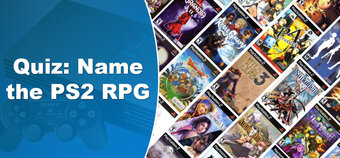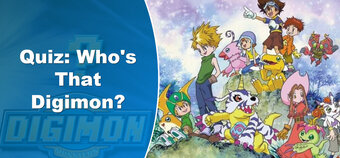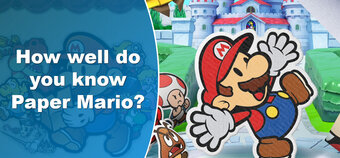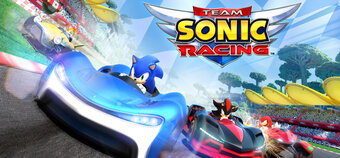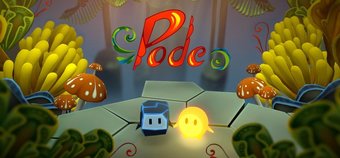There are few things worse in life than that feeling of disappointment. All that anticipation, all that excitement, all that build up, and then poof, it goes off not with a bang, but in a pathetic little whimper, as you're left to spend the next few weeks feeling sorry for yourself, and pondering how much better things could have been. And, sadly, that's the feeling we've been left with from Paper Mario: Sticker Star.
After all, this is a game that had everything going for it, and one that we we'd been seriously looking forward to ever since it was announced. As a new game in the Paper Mario series, we knew roughly what we ought to expect - a role playing game that blends simple, yet addictive turn based battles with a world populated by colourful, genuinely funny, yet utterly two-dimensional characters (in that they're made out of paper), to create a game that looked all but set to be one of the 3DS's finest. After all, it's not like the series didn't have a precedent. The original game, released late in the lift of the N64, was such a tour de force, that the GameCube sequel ended up being pretty much the same game with a new story tacked on top. For its Wii debut, the series had a slight divergence, becoming a pseudo-2D platformer, but it muddled through thanks to its essential charm and humour. But for Sticker Star? Well, the (sticker) stars haven't quite aligned as well as we might have hoped.
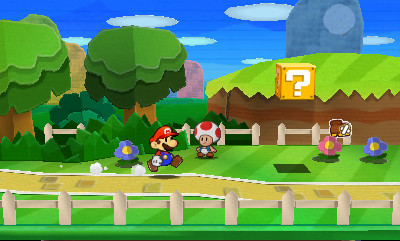
On the plus side, at least it's bright and colourful.
Things at least get off to a positive enough start. The game opens with the residents of the Mushroom Kingdom (basically, Peach and a dozen toads) in attendance at the Sticker Fest - a giant yearly gathering to celebrate the arrival of a Sticker Comet, which falls from the sky, and just happens to plonk itself in the middle of a stage, where everyone can admire it. Unfortunately, as is often the way with these sort of things, the notorious Bowser soon rears his ugly head and attempts to steal the comet - either to steal its phenomenal cosmic powers, or just to get on the Mushroom Kingdom's nerves. Stepping up the plate, the Toads try to defend against Bowser, but their plan backfires as Bowser ends up tripping and falling on top of the star, shattering it into a million tiny pieces, which coincidentally spread themselves across the far reaches of the Mushroom Kingdom. With the aid of one of the Royal Stickers, who seemingly happened to be aboard the cosmic Comet when it landed, it's up to you to hunt down the bits of the sticker and reunite it as one.
But it's how you're supposed to go about doing this that's a little bit different to the usual affair. While the previous games revolved around a plot, which basically guided you around the games huge worlds, dictating where you had to go next, who you had to speak to, and what items you had to try and discover, Paper Mario: Sticker Star has instead been divided into short, snappy levels, presumably to make the game more suited to handheld play. And initially, it's a decision that makes sense - after all, having to desperately backtrack through the level to try and find the nearest save point when you're nearing your bus stop does get frustrating after a while. But the problem is, rather than helping make the game pick-up-and-play, the levels have eaten away at the game's heart. Instead of relying on a story, and the lovable characters within, you now simply move from one level to the next, each of which are barely populated - at least, with people you can talk to. With no memorable characters to keep you going from one level to the next, and little in the way of a plot to give you direction, in the end, all you're left with is a traipse from one end of a level to the other, and a few battles thrown in for good measure along the way.
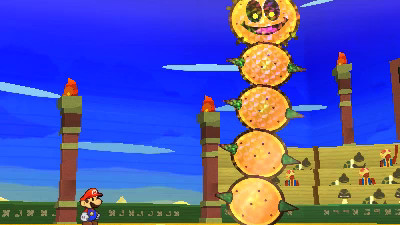
He may look happy - but he's just trying to lull you into a false sense of security. Not sure what's going on with the Toad businessmen in the background though.
And again, this shouldn't be a problem - the battles were one of the best parts of the earlier Paper Mario games, but for Sticker Star, they've ended up being stripped of much of their appeal. Much like in the previous games, as you stroll around each of the levels, you'll come across a variety of baddies going about their business. Catch their eye, and they'll charge at you, with the game switching to a turn-based battle when you make contact - if you've got good reactions, you can whack them with your hammer before they hit you (or, even better, sneak up before they've noticed you) to get a head start - if not, they'll clonk into you, and have the first move in the next battle.
For the most part, though, the battles themselves remain much the same as in the older games - as accessible, turn-based affairs, you're free to take time to plan your moves and weigh up your options, without having to worry about beating your enemy to the punch. However, it's how you make that punch that's the source of the biggest changes. Scattered around each of the levels, plastered to buildings, or hidden behind bushes, you'll come across dozens of stickers which you can peel off and add to your collection. But far from just being random collectables, these stickers are then used to perform attacks in battle. Rather than choosing what move to use, or whether to use an item, you now choose which sticker you want to use, with each sticker representing a different type of move, whether it's firing a fireball at your enemies, jumping on their heads, or whacking them with a hammer. And as you may expect, there's something of a sticker hierarchy going on here too - basic stickers, which perform basic moves, are reasonably easy to come by; slightly rarer shiny stickers offer you souped up versions of each move; whilst the mega shiny stickers, which are larger than the rest, and as such often take up extra space in your sticker book (you can only hold a limited number of stickers at anyone time, so there's something of a trade off to be had) are as rare as hen's teeth. In fact, most mega shiny stickers can only be collected by finding certain, random items in the levels (a ceramic cat, or a fan), and then heading to a Toad who can convert them into stickers for you. It's worth bearing in mind that although you can use these all-powerful stickers in whichever battle you want to, it's best to hold them back for the next boss fight - with oodles of health to get down, you'll need the strongest stickers in your arsenal to beat them.
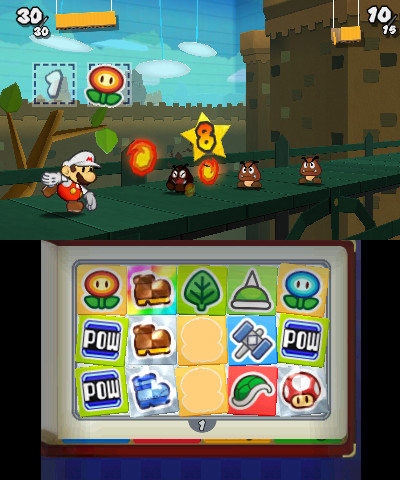
The battles have an interactive element - press A at the right time, and you can bounce on enemy's heads several times in a row, or do more damage with fireballs.
Sadly, though, there are more than a few things about the battle system that leave a sour taste in the mouth. The first is that you can't use stickers outside of battle, which is more of a problem than it seems. As your stickers also form your items, this means you can't use them to replenish your health after a battle, even if you have a whole sticker book full of mushrooms (which give you back several HP). When a battle's left you with 2 HP, and there are dozens of enemies between you and the end of the level, that can make things quite frustrating. But perhaps the biggest mistake here is that there's no levelling system to speak of. When you've finished a battle, you don't earn any XP, you don't level up, and you don't gain any strength whatsoever, so there's literally no benefit to you from taking part in battles.
Without the ability to make Mario and his team stronger, battles become an entirely pointless hindrance, and it affects how much fun you get out of playing the game. Rather than not really minding when you get caught, and drawn into a battle, the levels end up turning into an exercise in stealth, as you actively try to avoid any battles you can, knowing that any battle you may get caught up in can only slow you down, drain your health (which you then can't replenish) and waste your precious stickers - which you'll likely need for the next boss fight. If you could level up, you'd have a reason to get into the battles and make Mario stronger, but by removing any sort of levelling, they've turned the thing that makes up the majority of the game something you'll want to avoid. It's so backwards, it may as well be called Maper Pario.
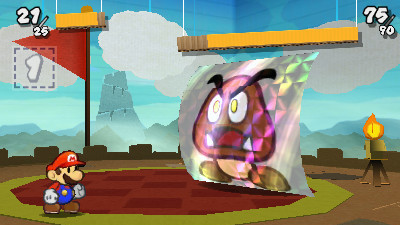
Bosses have huge amounts of health. Hopefully, you'll have kept your more powerful stickers.
Of course, another problem with using stickers is that, unlike simply choosing an attack to use, each sticker can only be used once. Although it's likely been intended to add an extra layer of strategy to the proceedings, what it actually means is you end up paranoid about using any and all stickers, as you don't want to risk running out (and unlike on games where you just choose a move to use, it's entirely possible to run out of stickers, and therefore moves, altogether). The more battles you get into, the less stickers you'll have available when you eventually have to take on a boss - and as the bosses often have an awfully large amount of health, they can take a lot of stickers to beat.
In the end, Nintendo have attempted to take Paper Mario: Sticker Star in a different direction, but the changes have all been rather misguided. Almost every change made has been to the detriment of the game, making its battles pointless, and its story weak, turning the game, at times, into more of a chore than something that's fun to play. And it's such a huge shame. There is still fun to be had here, but it's fun in spite of the changes rather than because of them - and it's a testament to how good Paper Mario was that, even in its new form, you can still have a bit of fun.
As we said at the start, there are few things worse than that feeling of disappointment - and when you were looking forward to a game quite as much as this one, and when you knew just how good it could have been, seeing the mistakes that have been made completely unnecessarily leaves you feeling somewhat, well, torn. As the old adage goes, if it ain't broke, don't fix it.
Format Reviewed: Nintendo 3DS








